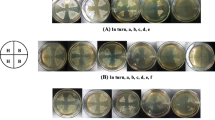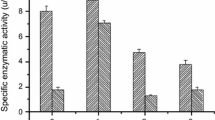Abstract
Seeking high strength vinegar fermentation by acetic acid bacteria (AAB) is still the mission of vinegar producers. AAB alcohol respiratory chain, located on intracellular membrane, is directly responsible for vinegar fermentation. In the semi-continuous vinegar fermentation by Acetobacter pasteurianus CICIM B7003, acetification rate showed positive correlation with the activity of the enzymes in alcohol respiratory chain. Aiming at achieving high strength fermentation process, a series of trials were designed to raise the activity of AAB alcohol respiratory chain. Finally, acetification was enhanced by adding some precursors (ferrous ions and β-hydroxybenzoic acid) of alcohol respiration associated factors and increasing aeration rate (0.14 vvm). As final result, average acetification rate has been raised to 2.29 ± 0.02 g/L/h, which was 28.7% higher than the original level. Simultaneously, it was found that the oxidization of alcohol into acetic acid in AAB cells was improved by well balancing of three factors: enzyme activity in alcohol respiratory chain, precursor of ubiquinone biosynthesis, and aeration rate.
Similar content being viewed by others
References
Azuma, Y., A. Hosoyama, M. Matsutani, N. Furuya, H. Horikawa, T. Harada, H. Hirakawa, S. Kuhara, K. Matsushita, N. Fujita, and M. Shirai (2009) Whole-genome analyses reveal genetic instability of Acetobacter pasteurianus. Nucleic Acids Res. 37: 5768–5783.
Bartowsky, E. J. and P. A. Henschke (2008) Acetic acid bacteria spoilage of bottled red wine. A review. Int. J. Food. Microbiol. 125: 60–70.
Yamada, Y. and P. Yukphan (2008) Genera and species in acetic acid bacteria. Int. J. Food. Microbiol. 125: 15–24.
Haruta, S., S. Ueno, I. Egawa, K. Hashiguchi, A. Fujii, M. Nagano, M. Ishiia, and Y. Igarashi (2006) Succession of bacterial and fungal communities during a traditional pot fermentation of rice vinegar assessed by PCR-mediated denaturing gradient gel electrophoresis. Int. J. Food. Microbiol. 109: 79–89.
Gullo, M., L. de Vero, and P. Giudici (2009) Succession of selected strains of Acetobacter pasteurianus and other acetic acid bacteria in traditional balsamic vinegar. Appl. Environ. Microbiol. 75: 2585–2589.
Baena-Ruano, S., C. Jiménez-Ot, I. M. Santos-Dueñas, J. E. Jiménez-Hornero, J. L. Bonilla-Venceslada, C. Álvarez-Cáliz, and I. GarcÍa-GarcÍa (2010) Influence of the final alcohol concentration on the acetification and production rate in the wine vinegar process. J. Chem. Technol. Biot. 85: 908–912.
Yakushi, T. and K. Matsushita (2010) Alcohol dehydrogenase of acetic acid bacteria: Structure, mode of action, and applications in biotechnology. Appl. Microbiol. Biot. 86: 1257–1265.
Kersters, K., P. Lisdiyanti, K. Komagata, and J. Swings (2006) The Family Acetobacteraceae: The genera Acetobacter, Acidomonas, Asaia, Gluconoacetobacter, Gluconobacter, and Kozakia. pp. 63–200. In: M. Dworkin, S. Falkow, E. Rosenberg, K. H. Schleifer, and E. Stackebrandt (eds.). The Prokaryotes: A Handbook on the Biology of Bacteria: Proteobacteria: Alpha and Beta sub classes. Springer, NY, USA.
González, B., S. MartÍnez, J. L. Chávez, S. Lee, N. A. Castro, M. A. DomÍnguez, S. Gómez, M. L. Contreras, C. Kennedy, and J. E. Escamilla (2006) Respiratory system of Gluconoacetobacter diazotrophicus PAL5 evidence for a cyanide-sensitive cytochrome bb and cyanide-resistant cytochrome ba quinol oxidases. B. B. A-Bioenergetics. 1757: 1614–1622.
Matsushita, K., H. Toyama, and O. Adachi (2004) Respiratory chains in acetic acid bacteria: Membrane-bound periplasmic sugar and alcohol respirations. pp. 81–99. In: D. Zannoni (ed). Respiration in Achaean and Bacteria. Springer, Dordrech, Netherlands.
Gullo, M., C. Caggia, L. de Vero, and P. Giudici (2006) Characterisation of acetic acid bacteria in traditional balsamic vinegar. Int. J. Food. Microbiol. 106: 209–212.
Tesfaye, W., M. L. Morales, M. C. Garčıa-Parrilla, and A. M. Troncoso (2002) Wine vinegar: Technology, authenticity and quality evaluation. Trends. Food. Sci. Tech. 13: 12–21.
Nakano, S., M. Fukaya, and S. Horinouchi (2004) Enhanced expression of aconitase raises acetic acid resistance in Acetobacter aceti. FEMS. Microbiol. Lett. 235: 315–322.
Nakano, S., M. Fukaya, and S. Horinouchi (2006) Putative ABC transporter responsible for acetic acid resistance in Acetobacter aceti. Appl. Environ. Microb. 72: 497–505.
Matsushita, K., H. Ebisuya, M. Ameyama, and O. Adachi (1992) Change of the terminal oxidase from cytochrome a1 in shaking cultures to cytochrome o in static cultures of Acetobacter aceti. J. Bacteriol. 174: 122–129.
Chinnawirotpisan, P., G. Theeragool, S. Limtong, H. Toyama, O. Adachi, and K. Matsushita (2003) Quinoprotein alcohol dehydrogenase is involved in catabolic acetate production, while NAD-dependent alcohol dehydrogenase in alcohol assimilation in Acetobacter pasteurianus SKU1108. J. Biosci. Bioeng. 96: 564–571.
Contreras-Zentella, M., G. Mendoza, J. Membrillo-Hernández, and J. E. Escamilla (2003) A novel double heme substitution produces a functional bo 3 variant of the quinol-oxidase aa3 of Bacillus cereus. J. Biol. Chem. 278: 31473–31478.
Lechardeur, D., B. Cesselin, A. Fernandez, G. Lamberet, C. Garrigues, M. Pedersen, P. Gaudu, and A. Gruss (2011) Using heme as an energy boost for lactic acid bacteria. Curr. Opin. Biotech. 22: 143–149.
Möbius, K., R. Arias-Cartin, D. Breckau, A. L. Hännig, K. Riedmann, R. Biedendieck, S. Schröder, D. Becher, A. Magalon, J. Moser, M. Jahn, and D. Jahn (2010) Heme biosynthesis is coupled to electron transport chains for energy generation. Proc. Natl. Acad. Sci. USA. 107: 10436–10441.
Meganathan, R. (2001) Ubiquinone biosynthsis in microorganisms. FEMS. Microbiol. Lett. 203: 131–139.
Paumann, M., G. Regelsberger, C. Obinger, and G. A. Peschek (2005) The bioenergetic role of dioxygen and the terminal oxidase(s) in cyanobacteria. B.B.A.-Bioenergetics. 1707: 231–253.
Anraku, Y. (1988) Bacterial electron transport chains. Annu. Rev. Biochem. 57: 101–132.
Park, Y.S., H. Ohtake, K. Toda, M. Fukaya, H. Okumura, and Y. Kawamura (1989) Acetic acid production using a fermentor equipped with a hollow fiber filter module. Biotechnol. Bioeng. 33: 918–923.
Toda, K., Y. S. Park, T. Asakura, C. Y. Cheng, and H. Ohtake (1989) High-rate acetic acid production in a shallow flow bioreactor. Appl. Microbiol. Biot. 30: 559–563.
Park, Y. S., K. Toda, M. Fukaya, H. Okumura, and Y. Kawamura (1991) Production of a high concentration acetic acid by Acetobacter aceti using a repeated fed-batch culture with cell recycling. Appl. Microbiol. Biot. 35: 149–153.
Author information
Authors and Affiliations
Corresponding author
Rights and permissions
About this article
Cite this article
Qi, Z., Yang, H., Xia, X. et al. High strength vinegar fermentation by Acetobacter pasteurianus via enhancing alcohol respiratory chain. Biotechnol Bioproc E 19, 289–297 (2014). https://doi.org/10.1007/s12257-013-0727-0
Received:
Revised:
Accepted:
Published:
Issue Date:
DOI: https://doi.org/10.1007/s12257-013-0727-0




